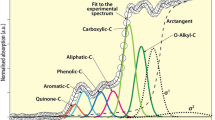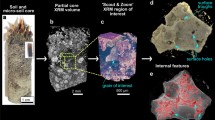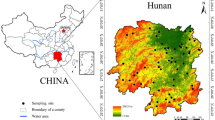Abstract
Soil erosion is attracting increasing attention worldwide as demands on land use increase with the growing human population. Arctic soils appear to be extremely sensitive to erosion by wind and water. Because of ice sheet erosion and massive exposure of fresh rock Arctic soils are often young and dominated by swelling clays. Freeze–thaw cycles in such water-adsorbing materials must influence the mechanics of the soil horizons. In this study using high-resolution cryo-electron microscopy we show the formation of ice in such clay structures and show that the freezing process can deform the clay structure and even produce particles of aerosol dimensions.
This is a preview of subscription content, access via your institution
Access options
Subscribe to this journal
Receive 51 print issues and online access
$199.00 per year
only $3.90 per issue
Buy this article
- Purchase on Springer Link
- Instant access to full article PDF
Prices may be subject to local taxes which are calculated during checkout
Similar content being viewed by others
References
Brown, L. R. & Wolf, E. C. Worldwatch Pap. No. 60 (1984).
A Growing Concern: Soil Degradation in Canada (Science Council of Canada, 1986).
Sparrow, H. O. Soil at Risk (The Senate of Canada, Ottawa, Ontario, 1984).
Chu, S. M. Land Resources in the Loess Plateau of China Vol. 2 (Shaanxi Science and Technique, Shaanxi, 1986).
Humphries, D. W. in The Encyclopedia of Sedimentology (eds Fairbridge, R. W. & Bourgeois, J.) 284–288 (Dowden, Hutchinson and Ross, Pennsylvania, 1978).
Suzuki, T. & Kamaya, A. JEOL Scanning Microscope 26, 2–5 (1986).
Inoue, T., Shimakura, S., Sato, T. & Koike, H. J. Scanning Electron Microscopy (Japan) 11, 26–28 (1982).
Shimakura, S. & Inoue, T. J. Electron Microsc. (Japan) 19, 172–176 (1985).
Inoue, T. in Science of Biological Specimen Preparation 245–256 (SEM Inc., AMF O'Hara, Chicago, 1986).
Inoue, T. & Osatake, H. J. Electron Microsc. 33, 356–362 (1984); Robards, A. W. & Sleytr, U. B. in Low-Temperature Methods in Biological Electron Microscopy (ed. Glauert, A.M.) 5–130 (Elsevier, New York, 1985).
Kenjo, T., Arai, H. & Suzuki, T. JEOL news 25E, 13–17 (1987).
Smart, P. & Tovey, N. K. in Electron Microscopy of Soils and Sediments 26–111 (Clarendon, Oxford, 1981).
Smart, P. & Tovey, N. K. in Electron Microscopy of Soils and Sediments 50–55 (Clarendon, Oxford, 1982).
Adrian, M., Dubochet, J., Lepault, J. & McDowall, A. W. Nature 308, 32–36, (1984).
Iwatsuki, M. & Harada, Y. J. Microsc. (Japan) 21, 174–179 (1987).
Iwatsuki, M., Kihara, H., Nakanishi, K. & Harada, Y. Proc. XIth Int. Cong. on Electron Microscopy Kyoto 251–254 (1986).
Nakazawa, H., Yamada, H., Fujita, T. & Ito, Y. Clay Sci. 6, 269–276 (1987).
Author information
Authors and Affiliations
Rights and permissions
About this article
Cite this article
Tazaki, K., Fyfe, W. & Iwatsuki, M. Clues to Arctic soil erosion from cryo-electron microscopy of smectite. Nature 333, 245–247 (1988). https://doi.org/10.1038/333245a0
Received:
Accepted:
Issue Date:
DOI: https://doi.org/10.1038/333245a0
Comments
By submitting a comment you agree to abide by our Terms and Community Guidelines. If you find something abusive or that does not comply with our terms or guidelines please flag it as inappropriate.



